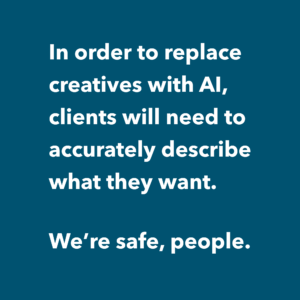Congratulations, you got your first book deal! Now you’re probably wondering, “What royalties will I…
How Concerned Should Illustrators Be About AI (Artificial Intelligence)?
With AI (Artificial Intelligence) so prominent these days, it’s easy to feel like the sky is falling in the illustration world, but is it really the existential threat to our field that many illustrators fear? The answer is both yes and no.
There’s a meme that went around a while ago back that jokes that, in order to replace [insert design speciality here] with AI, clients will need to accurately describe what they want, therefore we’re safe.

It’s funny, but it does have some truth, even if minimizing the impact of AI on the creative job market. In regards to illustration, AI is a prompt-based tool at its heart. It spits out options, with every prompt and refinement a gamble—Will this word jumble be the one that truly fulfills the creative brief? This mistakes the nature of illustration. Illustration is collaboration. It’s an art director working in conjunction with an illustrator to achieve a goal. It requires thoughtfulness, invention, point of view, and teamwork—all things a computer can’t do. AI can create a facsimile of a Norman Rockwell, but it cannot create an actual Norman Rockwell. It’s the Uncanny Valley of art.
Now, this does not mean that illustrators are safe from AI or its ramifications. In fact, quite the opposite. AI represents a serious threat to artists whose styles have been used to train AI models without their permission, resulting in a significant devaluation of their work. And clients who are less discerning about quality or artistic voice will certainly turn to AI, and already have begun to. After all, sometimes “good enough” is really just that—good enough. Why pay more if you don’t need to? This will most certainly affect the bottom and middle of the illustration market as those jobs evaporate and even affect the top tier. But clients who know and respect the medium or require something custom or with a voice will always be commissioning.
One way of viewing AI in regards to illustration is to look at stock photography. When stock photography came out, illustration suffered, but it didn’t die. Stock became one option among many for creatives to use. AI will just be another branch of that tree. A client can choose to utilize AI, stock, photography, or original illustration when executing a creative brief. Illustration and AI can co-exist. It might not be the rosiest picture, but illustration isn’t going away.
So, how should illustrators deal with AI? First, they should learn it and understand its possibilities and limits—both technical and legal. (And there are certainly a lot of legal issues around it!) With that knowledge, illustrators can evaluate whether it makes sense to wrap AI into their work in ways small or large and what those ramifications would be.
The second way for illustrators to face the growing threat of AI is to simply be better illustrators—give clients something greater than what an algorithm can achieve. Lean more into voice and point of view, substance over style. Collaborate. Be a value add. That will, at least, give illustrators a fighting chance.
AI is here to stay. It’s a scary and very real concern and it will certainly impact the field, and already has. But the illustration industry is resilient and has weathered many storms. Illustration has never been a reliable career and the addition of AI doesn’t make it any safer, but there is still a future for those illustrators nimble enough to face the AI challenge head on.
It is important to become familiar with AI and understanding its technical and legal possibilities and limitations is especially relevant in a context where technology is constantly evolving.
Thank you